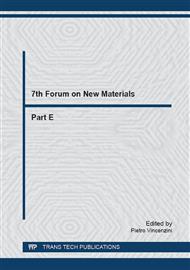[1]
J. Holnicki-Szulc, M. Ichchou, Z. Duan, Ł. Jankowski, Adaptive Impact Absorption, Math Probl Eng (2016) 4871549.
Google Scholar
[2]
G. Mikułowski, Ł. Jankowski, Adaptive Landing Gear: optimum control strategy and potential for improvement, Shock Vib 16 (2009) 175-194.
DOI: 10.1155/2009/732803
Google Scholar
[3]
B. Dyniewicz, R. Konowrocki, C.I. Bajer, Intelligent adaptive control of the vehicle-span/track system, Mech Syst Signal Pr 58-59 (2015) 1-14.
DOI: 10.1016/j.ymssp.2014.12.007
Google Scholar
[4]
A. Pręgowska, R. Konowrocki, T. Szolc, On the semi-active control method for torsional vibrations in electro-mechanical systems by means of rotary actuators with a magneto-rheological fluid, J Theor Appl Mech 51 (2013) 979-992.
Google Scholar
[5]
A. Mróz, J. Holnicki-Szulc, J. Biczyk, Prestress accumulation-release technique for damping of impact-born vibrations: Application to self-deployable structures, Math Probl Eng (2015) 720236.
DOI: 10.1155/2015/720236
Google Scholar
[6]
J.M. Bajkowski, B. Dyniewicz, C.I. Bajer, Semi-active damping strategy for beams system with pneumatically controlled granular structure, Mech Syst Signal Pr 70-71 (2016) 387-396.
DOI: 10.1016/j.ymssp.2015.09.026
Google Scholar
[7]
B. Dyniewicz, J.M. Bajkowski, C.I. Bajer, Semi-active control of a sandwich beam partially filled with magnetorheological elastomer, Mech Syst Signal Pr 60-61 (2015) 695-705.
DOI: 10.1016/j.ymssp.2015.01.032
Google Scholar
[8]
A. Mróz, A. Orłowska, J. Holnicki-Szulc, Semi-active damping of vibrations. Prestress Accumulation-Release strategy development, Shock Vib 17 (2010) 123-136.
DOI: 10.1155/2010/126402
Google Scholar
[9]
W.W. Clark, Vibration control with state-switched piezoelectric materials, J Intel Mat Syst Str 11 (2000) 263-271.
Google Scholar
[10]
S. Mohammadi, Semi-passive vibration control using shunted piezoelectric materials (2008) PhD Thesis, Department of Electrical Engineering, INSA-Lyon.
Google Scholar
[11]
D.F. Ledezma Ramirez, Shock isolation using switchable stiffness (2008) PhD Thesis, Institute of Sound and Vibration Research, University of Southampton.
Google Scholar
[12]
L. Gaul, R. Nitsche, The role of friction in mechanical joints. Appl Mech Rev 54 (2001) 93-106.
Google Scholar
[13]
J. Becker, L. Gaul, Semi–active control of adaptive friction dampers for structural vibration control. In: 25th IMAC (2007) 78-86.
Google Scholar


